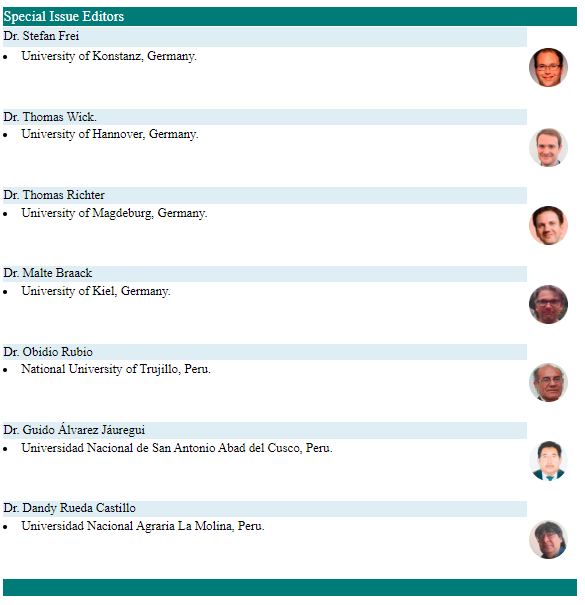A primal dual mixed finite element method for inverse identification of the diffusion coefficient and its relation to the Kohn-Vogelius penalty method
DOI:
https://doi.org/10.17268/sel.mat.2023.01.02Palavras-chave:
Unique continuation, Mixed finite element method, StabilityResumo
We revisit the celebrated Kohn-Vogelius penalty method and discuss how to use it for the unique continuation problem where data is given in the bulk of the domain. We then show that the primal-dual mixed finite element methods for the elliptic Cauchy problem introduced in [1] (E. Burman, M. Larson, L. Oksanen, Primal-dual mixed finite element methods for the elliptic Cauchy problem, SIAM J. Num. Anal., 56 (6), 2018) can be interpreted as a Kohn-Vogelius penalty method and modify it to allow for unique continuation using data in the bulk. We prove that the resulting linear system is invertible for all data. Then we show that by introducing a singularly perturbed Robin condition on the discrete level sufficient regularization is obtained so that error estimates can be shown using conditional stability. Finally we show how the method can be used for the identification of the diffusivity coefficient in a second order elliptic operator with partial data. Some numerical examples are presented showing the performance of the method for unique continuation and for impedance computed tomography with partial data.
Referências
Burman E, Larson MG, Oksanen L. Primal-dual mixed finite element methods for the elliptic Cauchy problem. SIAM J Numer Anal. 2018;56(6):3480-509. Available from: https://doi.org/10.1137/17M1163335.
Calderón AP. On an inverse boundary value problem. In: Seminar on Numerical Analysis and its Applications to Continuum Physics (Rio de Janeiro, 1980). Soc. Brasil. Mat., Rio de Janeiro; 1980. p. 65-73.
Uhlmann G. Electrical impedance tomography and Calderón’s problem. Inverse Problems. 2009;25(12):123011, 39. Available from: https://doi.org/10.1088/0266-5611/25/12/123011.
Kohn RV, McKenney A. Numerical implementation of a variational method for electrical impedance tomography. Inverse Problems. 1990;6(3):389-414. Available from: http://stacks.iop.org/0266-5611/6/389.
Knowles I. A variational algorithm for electrical impedance tomography. Inverse Problems. 1998;14(6):1513-25. Available from: https://doi.org/10.1088/0266-5611/14/6/010.
Gehre M, Jin B, Lu X. An analysis of finite element approximation in electrical impedance tomography. Inverse Problems. 2014;30(4):045013, 24. Available from: https://doi.org/10.1088/0266-5611/30/4/045013.
Rondi L. Discrete approximation and regularisation for the inverse conductivity problem. Rend Istit Mat Univ Trieste. 2016;48:315-52. Available from: https://doi.org/10.13137/2464-8728/13162.
Hinze M, Kaltenbacher B, Quyen TNT. Identifying conductivity in electrical impedance tomography with total variation regularization. Numer Math. 2018;138(3):723-65. Available from: https://doi.org/10.1007/s00211-017-0920-8.
Harrach B. An introduction to finite element methods for inverse coefficient problems in elliptic PDES. Jahresber Dtsch Math-Ver. 2021;123(3):183-210. Available from: https://doi.org/10.1365/s13291-021-00236-2.
Choulli M. Comments on the determination of the conductivity by boundary measurements. J Math Anal Appl. 2023;517(2):Paper No. 126638, 31. Available from: https://doi.org/10.1016/j.jmaa.2022.126638.
Burman E. Stabilized finite element methods for nonsymmetric, noncoercive, and ill-posed problems. Part I: Elliptic equations. SIAM J Sci Comput. 2013;35(6):A2752-80. Available from: https://doi.org/10.1137/130916862.
Burman E. Error estimates for stabilized finite element methods applied to ill-posed problems. C R Math Acad Sci Paris. 2014;352(7-8):655-9. Available from: https://doi.org/10.1016/j.crma.2014.06.008.
Burman E. Stabilised finite element methods for ill-posed problems with conditional stability. In: Building bridges: connections and challenges in modern approaches to numerical partial differential equations. vol. 114 of Lect. Notes Comput. Sci. Eng. Springer, [Cham]; 2016. p. 93-127.
Burman E. The elliptic Cauchy problem revisited: control of boundary data in natural norms. C R Math Acad Sci Paris. 2017;355(4):479-84. Available from: https://doi.org/10.1016/j.crma.2017.02.014.
Burman E, Hansbo P, Larson MG. Solving ill-posed control problems by stabilized finite element methods: an alternative to Tikhonov regularization. Inverse Problems. 2018;34(3):035004, 36. Available from: https://doi.org/10.1088/1361-6420/aaa32b.
Burman E, Nechita M, Oksanen L. Unique continuation for the Helmholtz equation using stabilized finite element methods. J Math Pures Appl (9). 2019;129:1-22. Available from: https://doi.org/10.1016/j.matpur.2018.10.003.
Burman E, Nechita M, Oksanen L. A stabilized finite element method for inverse problems subject to the convection-diffusion equation. I: diffusion-dominated regime. Numer Math. 2020;144(3):451-77. Available from: https://doi.org/10.1007/s00211-019-01087-x.
Wexler A, Fry B, Neuman M. Impedance-computed tomography algorithm and system. Applied optics. 1985;24(23):3985-92.
Kohn RV, Vogelius M. Relaxation of a variational method for impedance computed tomography. Comm Pure Appl Math. 1987;40(6):745-77. Available from: https://doi.org/10.1002/cpa.3160400605.
Ben Belgacem F, Girault V, Jelassi F. Full discretization of Cauchy's problem by Lavrentiev-finite element method. SIAM J Numer Anal. 2022;60(2):558-84. Available from: https://doi.org/10.1137/21M1401310.
Ben Belgacem F, Jelassi F, Girault V. Uniqueness failure for the finite element Cauchy-Poisson's problem. Comput Math Appl. 2023;135:77-92. Available from: https://doi.org/10.1016/j.camwa.2023.01.010.
Raviart PA, Thomas JM. A mixed finite element method for 2nd order elliptic problems. In: Mathematical aspects of finite element methods (Proc. Conf., Consiglio Naz. delle Ricerche (C.N.R.), Rome, 1975). Lecture Notes in Math., Vol. 606. Springer, Berlin; 1977.p.292-315.
Alessandrini G, Rondi L, Rosset E, Vessella S. The stability for the Cauchy problem for elliptic equations. Inverse Problems. 2009;25(12):123004, 47. Available from: https://doi.org/10.1088/0266-5611/25/12/123004.
Robbiano L. Théoreme d'unicité et controle pour les équations hyperboliques. In: Nonlinear partial differential equations and their applications. College de France Seminar, Vol. XIII (Paris, 1994/1996). vol. 391 of Pitman Res. Notes Math. Ser. Longman, Harlow; 1998. p. 294-302.
Downloads
Publicado
Como Citar
Edição
Seção
Licença
Copyright (c) 2023 Selecciones Matemáticas

Este trabalho está licenciado sob uma licença Creative Commons Attribution 4.0 International License.
Os autores que publicam nesta revista aceitam as seguintes condições:
Os autores mantêm os direitos autorais e atribuem à revista o direito da primeira publicação, com o trabalho registrado com a licença de atribuição Creative Commons Atribución 4.0 Internacional (CC BY 4.0), que permite que terceiros usem o material publicado sempre que mencionarem a autoria do trabalho e os direitos autorais. Primeira publicação nesta revista.
Os autores podem fazer outros acordos contratuais independentes e adicionais para a distribuição não exclusiva da versão do artigo publicada nesta revista (por exemplo, incluí-la em um repositório institucional ou publicá-la em um livro), desde que afirme claramente que o trabalho Foi publicado nesta revista.
É permitido e recomendado aos autores que publiquem seus trabalhos na Internet (por exemplo, em páginas institucionais ou pessoais) antes e durante o processo de revisão e publicação, pois isso pode levar a trocas produtivas e a uma disseminação maior e mais rápida do trabalho. publicado (Consultar: efeito do acesso aberto).












